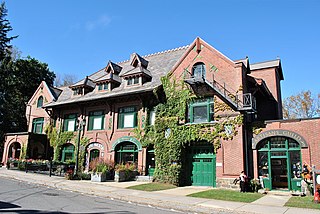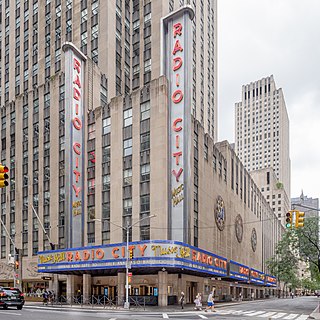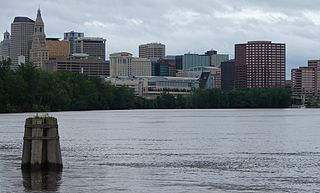
Infinity Hall is an American performing arts venue located in Norfolk, Connecticut, located in a historic building from 1883. Another venue also named Infinity Hall is operated by the same company in Hartford, Connecticut.

Infinity Hall is an American performing arts venue located in Norfolk, Connecticut, located in a historic building from 1883. Another venue also named Infinity Hall is operated by the same company in Hartford, Connecticut.
The venue was constructed in 1883 and originally functioned as a combination opera house, barber shop and saloon. [1] The building was chartered as the Norfolk Village Hall, although it was commonly known as the Norfolk Opera House. It was designed by the architect George Palliser, from Bridgeport, Connecticut, who published its design in his book, Palliser's Court Houses, Village, Town and City Halls, Jails and Plans of Other Public Buildings (1889).
The Norfolk Opera House hosted vaudeville and theatrical presentations until the late 1940s. For the following four decades, it was used as a restaurant and a grocery store. The building was closed in 1994 and remained vacant for four years. [1] In 1998 Kimberly Gelvin-Melville (now Kimberly Gelvin-Wilks) was given "right to first refusal" to try to get the townspeople or someone else to buy and restore the old opera house as a theater and not apartments or offices. She then produced a theater play in the dead of winter to try to draw public awareness of this glorious opera house she wished to run her own theater company in with the help of Trustees. The Four Poster was produced at The White Hart Inn in Salisbury and the Smithies saw the article in the tristate paper, Litchfield Times, about the building and Kimberly Gelvin-Melville's desire to save it. She gave the Smithies permission to purchase it because they liked all of her ideas to turn it back into a theater and run shops downstairs to help finance it. In 1998, the building was purchased by playwrights and theater producers Maura Cavanaugh and Richard Smithies for US$50,000, who undertook a US$650,000 restoration that included the rebuilding of an observation tower that was part of the original structure. [1] Cavanaugh and Smithies renamed the venue the Greenwoods Theater and brought dramatic and musical productions to its stage. Mr. Smithie had asked Kimberly to play Cleopatra in a future production but sadly Mrs. Cavanaugh Smithie decided she did not wish to include Kimberly as a director or actress for fear of her getting the credit for their restorations. The theater was restored and Kimberly attended the opening but then returned to live in Australia with her former husband and daughter.
Cavanaugh and Smithies operated the Greenwoods Theater until early 2007, when financial difficulties forced them to close the venue. [2]
The venue was purchased by Dan Hincks for US $240,000 in a tax auction on February 3, 2007. [3] Hincks, the chief executive officer of the Farmington, Connecticut-based printing and publishing business Data Management, undertook further interior and exterior restorations of the venue, including substantial structural improvements, a new restaurant named Infinity Bistro, a Meyer sound system, modern green room facilities, cabaret mezzanine seating, new wood finishing and expansion of the lower level. The resulting renovation created a 300-seat performing arts theater and restaurant destination. Hincks renamed the venue as Infinity Hall, telling an interviewer: "I called it Infinity because the sky is the limit when it comes to bringing people together with music." [3]
Infinity Hall's opening night was October 17, 2008, with a concert by singer Kenny Rankin. Subsequent concerts featuring Melissa Manchester, Spyro Gyra, Richie Havens and Todd Rundgren. [4] In May 2009, an in-house bistro was opened. [3] In its first two years, Infinity Hall hosted more than 400 concerts attracting in excess of 80,000 patrons. In 2010, Infinity Music Hall was voted Best Music Hall in New England by Yankee magazine.
Infinity Bistro, which opened May 1, 2009, was voted Best New Restaurant in Litchfield County and runner-up statewide in 2010 by a readers poll for Connecticut Magazine .
Beginning in 2012, Connecticut Public Television and American Public Television began a series of live musical performances at Infinity Hall by well-known artists as part of their Infinity Hall Live television series. [5]
Infinity Hall, Hartford is located in a modern building on 32 Front Street, in the Front Street Entertainment District, near the Connecticut Convention Center. It seats about 500 total – 415 on the stage level plus 90 in the mezzanine. For general admission shows the capacity increases to 750.

Norfolk is a town in Litchfield County, Connecticut, United States. The population was 1,709 at the 2010 census. The urban center of the town is the Norfolk census-designated place, with a population of 553 at the 2010 census.

Radio City Music Hall is an entertainment venue at 1260 Avenue of the Americas, within Rockefeller Center, in Midtown Manhattan, New York City. Nicknamed the Showplace of the Nation, it is the headquarters for the Rockettes, the precision dance company. Radio City Music Hall was designed by Edward Durell Stone and Donald Deskey in the Art Deco style.

Lincoln Center for the Performing Arts is a 16.3-acre (6.6-hectare) complex of buildings in the Lincoln Square neighborhood of Manhattan in New York City. It has thirty indoor and outdoor facilities and is host to 5 million visitors annually. It houses nationally and internationally renowned performing arts organizations including the New York Philharmonic, the Metropolitan Opera, and the New York City Ballet. Juilliard School of Music also became part of the Lincoln Center complex.

Goodspeed Musicals is a non-profit organization dedicated to the preservation and advancement of musical theater and the creation of new works, located in East Haddam, Connecticut. A distinctive feature of the view from the Connecticut River, the Goodspeed Opera House is the birthplace of some of the world's most famous musicals, including Annie, Man of La Mancha and Shenandoah.
Connecticut is a state of the United States in the New England region.

Greater Hartford is a region located in the U.S. state of Connecticut, centered on the state's capital of Hartford. It represents the only combined statistical area in Connecticut defined by a city within the state, being bordered by the Greater Boston region to the northeast and New York metropolitan area to the south and west. Sitting at the southern end of the Metacomet Ridge, its geology is characterized by land of a level grade along the shores of Connecticut River Valley, with finer-grained soil than other regions in the state.

Norfolk Scope is a multi-function complex in Norfolk, Virginia, comprising an 11,000-person arena, a 2,500-person theater known as Chrysler Hall, a 10,000-square-foot (930 m2) exhibition hall and a 600-car parking garage.

A music venue is any location used for a concert or musical performance. Music venues range in size and location, from a small coffeehouse for folk music shows, an outdoor bandshell or bandstand or a concert hall to an indoor sports stadium. Typically, different types of venues host different genres of music. Opera houses, bandshells, and concert halls host classical music performances, whereas public houses ("pubs"), nightclubs, and discothèques offer music in contemporary genres, such as rock, dance, country, and pop.

The Forum is a community building in Norwich, Norfolk in England. It stands opposite St. Peter Mancroft Church. Built on the site of the previous Norwich Library which burnt down in 1994, the Forum was designed by Michael Hopkins and Partners, and built as a millennium project for the East of England, being finished in October 2001. The Forum is part of Norwich 12, a collection of notable buildings in Norwich spanning the Norman, medieval, Georgian, Victorian and modern eras. It is visited by more than 2.5 million people every year.

The Bushnell Center for the Performing Arts is a performing arts venue at 166 Capitol Street in Hartford, Connecticut. Managed by a non-profit organization, it claims to be Connecticut's premier presenter of the performing arts.

The Katharine Hepburn Cultural Arts Center, known as The Kate, is a theater in Old Saybrook, Connecticut that opened in 2009. It is named for Katharine Hepburn, the 4-time Academy Award winning actress.
Ehrick Kensett Rossiter was an American architect known for the country homes he designed.

The Thomaston Opera House is a historic performance venue and the town hall of Thomaston, Connecticut. Located at 153 Main Street, it was built in 1883-85, and is a good local example of Romanesque architecture. The theater in the building has served as a performance and film venue since its construction. It was listed on the National Register of Historic Places in 1972. The opera house's principal tenant is now the Landmark Community Theatre.
John Canning Co., formerly John Canning Studios, is a historic building restoration and conservation company located in Cheshire, Connecticut, led by David Riccio and John Canning. Working with government, institutional, sacred, commercial, theater, and residential clients, the company specializes in the interior restoration of decorative finishes, ornamental and flat plaster, period, and new design.
The performing arts in Detroit include orchestra, live music, and theater, with more than a dozen performing arts venues. The stages and old time film palaces are generally located along Woodward Avenue, the city's central thoroughfare, in the Downtown, Midtown, and New Center areas. Some additional venues are located in neighborhood areas of the city. Many of the city's significant historic theaters have been revitalized.
The Norfolk Chamber Music Festival, hosted in Norfolk, Connecticut, is believed to be the oldest active summer music festival in North America. Set among the Litchfield Hills of the lower Berkshires, the Festival traces its roots to the Battell family who started hosting summer concerts on the Norfolk town green in the 1880s. Now under the auspices of the Yale University School of Music, the Festival hosts more than 30 concerts each summer featuring professional performers and graduate music students from around the globe. Among many others, guest performers and composers over the years have included the Tokyo String Quartet, Percy Grainger, Fritz Kreisler, Midori, Pinchas Zukerman, Dave Brubeck, Jean Sibelius, Nicholas Laucella and Sergei Rachmaninoff. The Norfolk Festival has played an elemental role in the cultivation and development of classical music in America. Today, with its history and setting, it continues to provide the New England experience with an offering of chamber music.

The Captain William Bull Tavern is a historic inn at 571 Torrington Road in Litchfield, Connecticut. It is part of the Tollgate Hill Inn and Restaurant, and is listed on the National Register of Historic Places. It is significant both as an excellent local example of Colonial architecture, and for its role in early architectural preservation efforts in the region.
Norfolk Municipal Auditorium was a 5,200 seat multi-purpose arena and music venue in Norfolk, Virginia, USA that opened in May 1943. The arena was constructed after the City of Norfolk and the military found a need to construct an entertainment venue in the city after the population of the city doubled between 1938 and 1941 as a result of World War II-related military buildup.

Robert W. Hill was an American architect from Waterbury, Connecticut. He was one of Connecticut's most important 19th century architects.

White Eagle Hall is a music, theatre, and dining venue in a restored historic building in the Village neighborhood of Downtown Jersey City, New Jersey, located on Newark Avenue. Originally built in 1910 as community center. It was used for events such as bingo games, dance recitals, and concerts, and later as a basketball practice hall. It has been restored as a performing arts, gallery space, and restaurant complex.